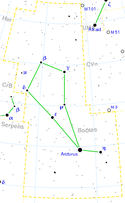Seginus
| Seginus (γ) | |
| Observationsdata Epok: J2000.0 | |
|---|---|
| Stjärnbild | Björnvaktaren |
| Rektascension | 14t 32m 04,67180s[1] |
| Deklination | 38° 18′ 29,7043″[1] |
| Skenbar magnitud () | 3,03 [2] |
| Stjärntyp | |
| Spektraltyp | A7 III[3] |
| U–B | 0,12[2] |
| B–V | 0,19[2] |
| Variabeltyp | Pulserande variabel av Delta Scuti-typ[[3]3] |
| Astrometri | |
| Radialhastighet () | -35,5 [4] km/s |
| Egenrörelse (µ) | RA: -115,71[1] mas/år Dek.: 151,16[1] mas/år |
| Parallax () | 37,58 ± 0,14[1] mas |
| Avstånd | 86,8 ± 0,3 lå (26,61 ± 0,10 pc) |
| Absolut magnitud () | 0,91[5] |
| Detaljer | |
| Radie | 3,26[5] R☉ |
| Luminositet | 34 [[3] L☉ |
| Temperatur | 7 800[3] K |
| Vinkelhastighet | 140[3] |
| Andra beteckningar | |
| Haris, Ceginus, Segin, 27 Bootis, BD+ 38° 2565, FK5 535, HD 127762, HIP 71075, HR 5435, SAO 64203. [6] | |
Seginus, eller Gamma Bootis (γ Bootis, förkortat gamma Boo, γ Bu), som är stjärnans Bayerbeteckning,[7] är en blå jättestjärna[5] i stjärnbilden Björnvaktaren. Den befinner sig på ett avstånd av cirka 85 ljusår från solen, tillhör spektralklass A7III och är en variabel stjärna av typen Delta Scuti, med en rotationstid på 1,13 timmar.[3] Dess ljusstyrka varierar inom magnitud 3,02-3,07.
Nomenklatur
Stjärnans traditionella namn, Seginus (alternativt Segin, Ceginus) är av osäkert ursprung och noterades som Haris i Bečvář. Seginus kommer möjligen från en latinisering av en arabisk form av det grekiska namnet Theguius på stjärnbilden Björnvaktaren. Haris kommer från det arabiska namnet på stjärnbilden, Al Haris Al Sama, som betyder "vakten".
År 2016 organiserade internationella astronomiska unionen en arbetsgrupp för stjärnnamn (WGSN) [8] med uppgift att katalogisera och standardisera egennamn för stjärnor. WGSN fastställde namnet Seginus för denna stjärna den 21 augusti 2016 och det ingår nu i IAU:s Catalog of Star Names.[7]
I stjärnkatalogen i Calendarium of Al Achsasi al Mouakket, betecknas denna stjärna som Menkib al Aoua al Aisr (منكب العواء الأيسر - mankibu l'awwaa'i l'aysar ), som översatts till latin som Humerus Sinister Latratoris, som kan översättas till 'inkastarens vänstra skuldra’.[9]
Egenskaper
Seginus har identifierats som en dubbelstjärna, i vilket det finns åtminstone en stjärna i nära omloppsbana till en annan stjärna eller två eller fler stjärnor som kretsar kring en central punkt. Stjärnorna kan vara av samma massa, olika massa där en stjärna är starkare än den andra, eller vara i en grupp som kretsar kring en central punkt, som inte nödvändigtvis behöver vara en stjärna.[5]
Källor
- Den här artikeln är helt eller delvis baserad på material från engelskspråkiga Wikipedia, tidigare version.
Referenser
- ^ [a b c d e] van Leeuwen, F. (2007), "Validation of the new Hipparcos reduction", Astronomy and Astrophysics, 474 (2): 653–664, arXiv:0708.1752Freely accessible, Bibcode:2007A&A...474..653V, doi:10.1051/0004-6361:20078357.
- ^ [a b c] Mermilliod, J.-C. (1986), "Compilation of Eggen's UBV data, transformed to UBV (unpublished)", SIMBAD, Bibcode:1986EgUBV........0M.
- ^ [a b c d e f] Balona, L. A.; Dziembowski, W. A. (October 1999), "Excitation and visibility of high-degree modes in stars", Monthly Notices of the Royal Astronomical Society, 309 (1): 221–232, Bibcode:1999MNRAS.309..221B, doi:10.1046/j.1365-8711.1999.02821.x
- ^ Wilson, R. E. (1953), General Catalogue of Stellar Radial Velocities, Carnegie Institute of Washington D.C., Bibcode:1953GCRV..C......0W.
- ^ [a b c d] https://www.universeguide.com/star/seginus. Hämtad 2017-04-26
- ^ "gam Boo -- Variable Star of delta Sct type", SIMBAD Astronomical Database, Centre de Données astronomiques de Strasbourg, hämtad 2016-12-18.
- ^ [a b] "IAU Catalog of Star Names". Hämtad 28 juli 2016.
- ^ "IAU working group on star names (WGSN)". Hämtad 28 maj 2016.
- ^ Knobel, E. B. (June 1895). "Al Achsasi Al Mouakket, on a catalogue of stars in the Calendarium of Mohammad Al Achsasi Al Mouakket". Monthly Notices of the Royal Astronomical Society. 55: 429. Bibcode:1895MNRAS..55..429K. doi:10.1093/mnras/55.8.429.
Externa länkar
Media som används på denna webbplats
(c) Bronger from en.wikipedia.org, CC BY-SA 3.0
This is a celestial map of the constellation Bootes the Herdsman.
Copyright © 2003 Torsten Bronger.
It was created by Torsten Bronger using the program PP3 on 2003/07/23. At PP3's homepage, you also get the input scripts necessary for re-compiling the map.
The yellow dashed lines are constellation boundaries, the red dashed line is the ecliptic, and the shades of blue show Milky Way areas of different brightness. The map contains all Messier objects, except for colliding ones. The underlying database contains all stars brighter than 6.5. All coordinates refer to equinox 2000.0.
The map is calculated with the azimuthal equidistant projection (the azimuth being in the center of the image). The north pole is to the top. The (horizontal) lines of equal declination are drawn for 0°, ±10°, ±20° etc. The lines of equal rectascension are drawn for all 24 hours. The scale of the map is (approx.) 11.8 pixel per degree at the centre of the bitmap. Towards the rim there is a very slight magnification (and distortion).


